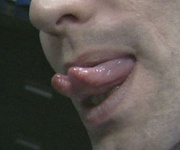Tongue Splitting FAQ
The tongue splitting procedure is the central bifurcation of the tongue, so as to achieve a "forked tongue." With practice, each half can be separately controlled.
Contents
- Placement
- Procedure
- Healing and aftercare
- Long-term health issues
- History
- Reversal
- Legality
- Related risks
- External links
Placement
The median fibrous septum that centrally divides the tongue is cut, separating the two lateral halves of the tongue. Done carefully, very little damage should be done in the process.
The tongue can, in theory, be split back to where it meets the base of the mouth. Attempting to split past that would endanger muscles that shouldn't be split, as well as glandular structures in the area. Note again that once the tongue is split further than suggested, there may be some minor speech artifacts.
It is not a good idea to cut the tongue in more than two pieces. To do so would risk cutting into the lingual nerves, the lingual glands, numerous major blood vessels, and it is dubious whether full nervous control could be sustained even if done by an oral surgeon. Attempting a "trifuraction" (or more) would almost certainly end in disaster.
Procedure
Tongue splitting can be accomplished by one or more of the following methods:
Oral surgery
The most recommended method is to seek an oral surgeon. Any oral surgeon who uses a laser should be able to bifurcate a tongue with ease, providing their ethics allow it...
Tie-off
Another one of the early methods; this procedure requires an already-healed tongue piercing in order to tie a tight loop parallel to the split along the center of the tongue...
Scalpelling
To put it simply, the tongue is split down the middle using a blade. This is generally very bloody, and this bleeding can be difficult to control...
Cauterizing
A cauterized tongue splitting is similar to a scalpelled tongue splitting, but a heated blade or tool is used to burn the split through the tongue...
Suturing
Suturing pulls the top skin of the tongue down into the split, leaving a more "natural" and rounded appearance that many people prefer...
Risks
Assuming the procedure is done by a doctor, the risks are negligible, and complications that arise in a controlled medical environment can typically be dealt with easily...
Healing and aftercare
Tongue splitting takes about as long to heal as tongue piercing does. Primary healing (where you can talk and eat relatively normally) takes between one and two weeks, and full healing is usually complete within one month.
Long-term health issues
Initial bleeding and infection can be a risk, especially with home-jobs...
History
Tongue splitting, to some, a pinnacle of "Khechari Mudra" practices, is a part of Hatha and Kumbhaka yoga where the tongue is split and then "milked" until it is long enough to be turned back inside the mouth and flipped up to the epiglottis...
Reversal
By removing the skin on the inside of the split and then suturing the tongue back together, it can be induced to "go back to normal..."
Legality
Having a tongue splitting is legal everywhere except in the US military...
